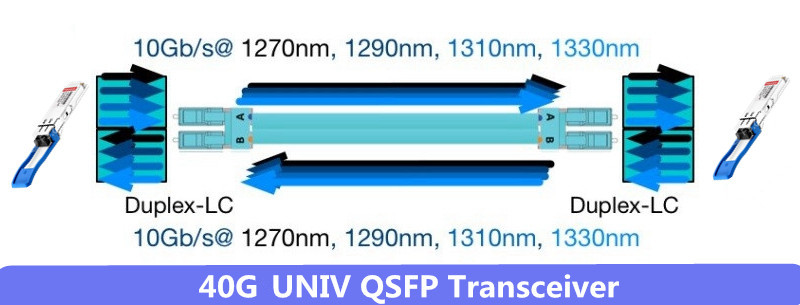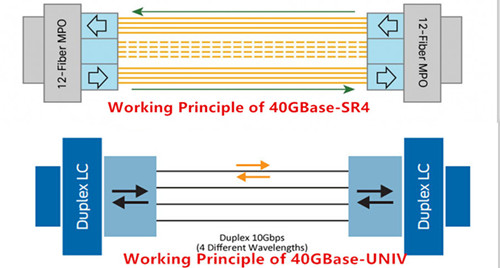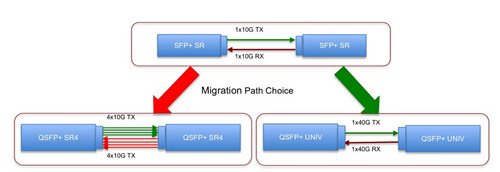Nowadays, the demand for high bandwidth increases and footprints for data center expands dramatically, which makes the migration from 10G to 40G much more necessary than ever before. Under this condition, many enterprises are ongoing or imminent to upgrade their data center network infrastructures. To better cater for our users, two transceivers 40G UNIV and 40G SWDM4 QSFP using SWDM (Short Wavelength Division Multiplexing) technology are compared in the following text, which intends to offer a cost effective transceiver solution for 10G to 40G migration applications. As parallel multimode MPO fiber cabling is much more expensive than Duplex-LC fiber cabling, Duplex-LC fiber patch cords will be used in these two SWDM applications, as a cost saving cabling method.
QSFP 40G UNIV Transceiver for SWDM Application
QSFP 40G UNIV is a kind of pluggable optical transceiver that fitted with Duplex-LC connector and can work with both single-mode and multimode fiber patch cable, originally released by Arista. Hence, it is also referred to as 40G SMF&MMF transceiver or 40G QSFP universal transceiver. When working with singlemode fiber, the Arista QSFP 40G UNIV can support 40G connection with a reach of 500m; and over OM3/OM4, the transmission distance can be up to 150m. Furthermore, the Arista QSFP 40G UNIV is designed with four 10G channels for transmitting and receiving four individual 10G signals through a single Duplex-LC fiber patch cord, for achieving a total 40G connection, as shown in the following figure.
How does the Arista QSFP 40G UNIV work for 40G connection? The answer is SWDM technology. With the help of SWDM, Arista QSFP 40G UNIV will multiplex four wavelengths 1270nm, 1290nm, 1310nm and 1330nm to transmit four 10G signals over the single Duplex-LC fiber patch cord. And when the aggregate 40G signal passes through the receiver end, it will be demultiplexed into four individual 10G signals again. As a result, an aggregate 40G signal can be transmitted through a single Duplex-LC fiber patch cord. In short, Arista 40G universal transceiver is a very good choice for 40G migration which can work with LC-duplex single-mode or multimode fiber, instead of high-cost parallel multimode MPO fiber cabling.
QSFP 40G SWDM4 Transceiver for SWDM Application
QSFP 40G SWDM4 is an updated optical transceiver that basically works with Duplex-LC fiber patch cord for short 40G fiber link. It has the same working principle that uses SWDM technology as the QSFP 40G UNIV one, but can perform better. How does it do this? Unlike QSFP 40G UNIV working with both single-mode and multimode fiber, the QSFP 40G SWDM4 is designed to work with multimode fiber, which can transmit a multiplexed 40G signal over wide band OM5 at lengths up to 440m. It can also work in multimode fiber OM3 and OM4 with a reach of 240m and 350m, separately. What’s more, the power dissipation of QSFP 40G SWDM4 can be as low as 1.5W* since SWDM technology can match 4x WDM optical architecture with 4x electrical interface.
Similar to the QSFP 40G UNIV transceiver, four different wavelengths, 850nm, 880nm, 910nm and 940nm are used in the QSFP 40G SWDM4 transceiver. To transmit a total 40G signal, these four wavelengths will be multiplexed to carry four individual 10G signals, be transmitted through the Duplex-LC multimode fiber patch cord and finally demultiplexed. To better understand the principle of QSFP 40G SWDM4 transceiver, you can learn the above figure that illustrates how does the QSFP 40G SWDM4 work for a short distance 40G fiber link.
QSFP-40G-UNIV vs QSFP-40G-SWDM4, Which One is Better?
After discussion, we can learn that both QSFP 40G UNIV and QSFP 40G SWDM4 transceivers enable network operators to grow the capacity of their networks without laying new fiber cabling. In view of the transmission distance, QSFP 40G SWDM4 transceiver working with OM5 supports a longer 40G fiber link than QSFP 40G UNIV with OM3/OM4, but a shorter 40G fiber link than QSFP 40G UNIV with single mode fiber cable. When taking fiber cabling infrastructure cost into consideration, OM5 cabling costs about 50% more than OM4 and singlemode fiber is also very expensive. Then which one should be selected? Just depending on your network needs, such as the fiber link distance, the budget, etc. To better know the differences between QSFP 40G UNIV and QSFP 40G SWDM4 transceivers, here offers a table that shows their detailed parameters.










